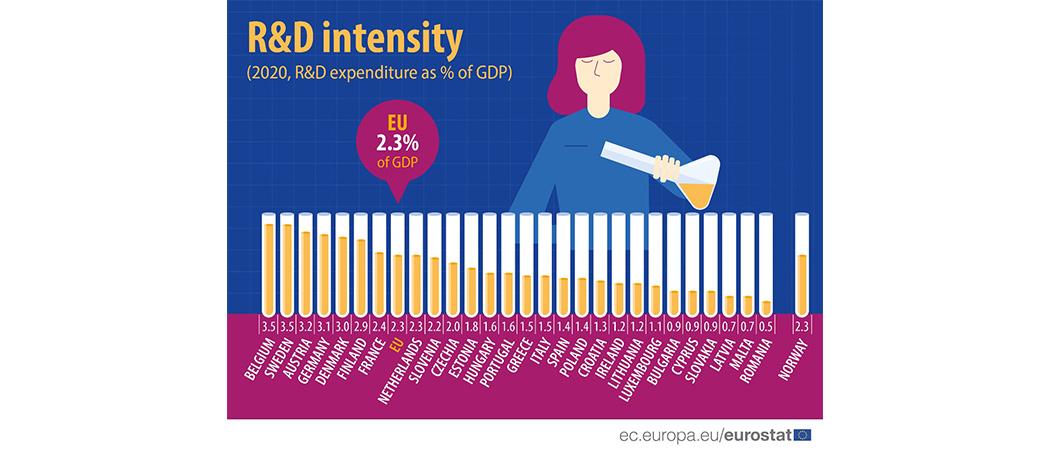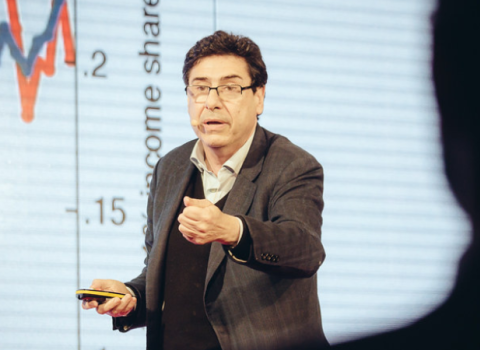As Science|Business launches its Widening newsletter, here’s an explainer on how the EU research programme is attempting to boost R&D performance in central and eastern Europe

R&D expenditure in the EU. Source: Eurostat
When it comes to research, Europe is divided. Talent and excellence are spread across the bloc, but stark differences between regions reveal themselves when measuring R&D performance. To bridge the gap, the EU is now running a Widening programme to help fifteen member states and a few associated countries, mostly located central and eastern Europe, catch up.
The Widening programme aimed at plugging the gap in R&I performance kicked off under Horizon 2020, with 1% of the 2014 - 2020 EU research budget dedicated to it – not a whole lot. It ran a variety of calls to help bridge the divide, but a recent EU auditor’s report found Widening was not a ‘miracle pill’ and needed to be complemented by reforms in member states.
But it was successful enough to justify carrying it forward to Horizon Europe, and MEPs and member states that get less money out of EU framework programmes than they pay in wanted to make it bigger and better. In 2019, EU research ministers ring-fenced 3.3% of the €95.5 billion EU research programme for Widening. The fight was difficult, and eastern and central European governments wanted even more money, but the agreement was hailed as a win.
The final shape of the programme the policymakers settled on has two parts: one is dedicated to increasing participation in EU research across the bloc while the other one aims to boost overall research excellence. In practice, it means increasing geographical diversity, building up R&I capacity and promoting networking between the east and the west.
We’re only a year and a half in, but the prospects for central and eastern Europe under Horizon Europe show promise. As of July, the 15 Widening countries are doing slightly better under Horizon Europe than they did under previous EU research programme, with a 13.6%, success rate, relatively closer to the overall member state average of 14.2%. They’re also getting more of the funding, securing 8.7% thus far under Horizon Europe, up from below 6% in Horizon 2020. Commission sources have showed cautious optimism when reflecting on the preliminary figures.
But not all numbers are positive. This week, the European Research Council (ERC) awarded its prestigious proof of concept grants to 55 researchers, but only one of them was from a Widening country, Cyprus. This is not an anomaly in the statistics: since 2011, with an average of 133 grants given out each year, only 73 have gone to current Widening countries.
Why should we care?
Widening is a political instrument. It’s a tangible response to the inequalities in the EU’s research ecosystem, aimed at preventing excellence accumulating in a few top places and stopping the brain drain from the east to the west.
It’s also strategic. Giving those that underperform a boost is a way to amplify the EU’s overall standing in research. Today, Europe is lagging behind the US and China in translating research into innovation. Lagging regions that are not taking full advantage of their talent pool and technological capacity contributes to the stagnation. If all parts of the bloc do well, European R&I will get a big boost.
That’s why back in 2020 the European Commission revived the ambition to create a European Research Area (ERA), a single market for research where knowledge, research outputs and talent circulate freely and rapidly. ERA has twenty goals that, among others, aim to bring up standards for research careers and align national plans and investment in a common strategy to multiply its effects and avoid duplications.
The Widening programme is part of the plan, but it’s not enough to make a difference on its own. To make the European Research Area stronger, national research and innovation policies and budgets need to be strengthened too.
On average, in 2020, EU member states spent 2.3% of their GDP on public and private research, but none of the Widening countries reached this average. Romania spent as little as 0.5% of its GDP on research. The only countries to reach the 2% mark were Slovenia and the Czech Republic – but they’re still a whole percentage point away from the EU-wide goal to spend 3% of GDP on public and private research by 2030, which ERA pact member states signed up to in 2020. A €3 billion EU programme cannot fill these gaps on its own.
And why now? The EU has big goals to meet in the green and digital transitions. At the same time crises break one after the other, from energy shortages to supply chain disruptions and the COVID-19 pandemi. Horizon Europe was designed to be more impact-driven to help tackle these societal challenges in the coming decade. The challenges are common, and more than ever, excellence must be everywhere, making Widening an ever more important endeavour.
The nitty gritty
As with the rest of Horizon Europe, Widening is run through calls for proposals. In the first two years of the programme, the calls target three main goals: improving access to excellence, attracting and mobilising talent, and enhancing and reforming the EU R&I system.
To improve access to excellence – the biggest slice of the pie in terms of budget – the Commission runs Teaming and Twinning calls, among others. Teaming helps countries establish new research facilities or modernise existing ones with the help of other leading institutions. Twinning, meanwhile, is about networking; it connects research institutions in Widening countries with those in other member states helping them to build the networks that are essential when it comes to forming consortia for European projects.
The talent part of the work programme aims to foster brain circulation by bringing ‘ERA Chairs’ - outstanding scientists and innovators, to Widening countries to run permanent research groups, thus creating ‘pockets of excellence’. There are also ERA Fellowships which support postdoctoral cross-border fellowships in Widening countries, run through Horizon Europe’s Marie Skłodowska-Curie Actions researcher mobility programme, as well as the ERA Talent programme, a type of grant that covers researcher training and mobility expenses in Widening countries.
The third part of the Widening work programme supports reforms in the EU’s R&I system. It runs a series of smaller calls aimed at setting the scene for an improved ERA. It’s built around four goals: prioritising investments and reforms, improving access to excellence, translating research results, and deepening the ERA.
In 2023 and 2024, the Commission is set to continue to run calls along the three lines, according to a leaked early draft work programme, but the final plan is yet to be revealed.





 A unique international forum for public research organisations and companies to connect their external engagement with strategic interests around their R&D system.
A unique international forum for public research organisations and companies to connect their external engagement with strategic interests around their R&D system.